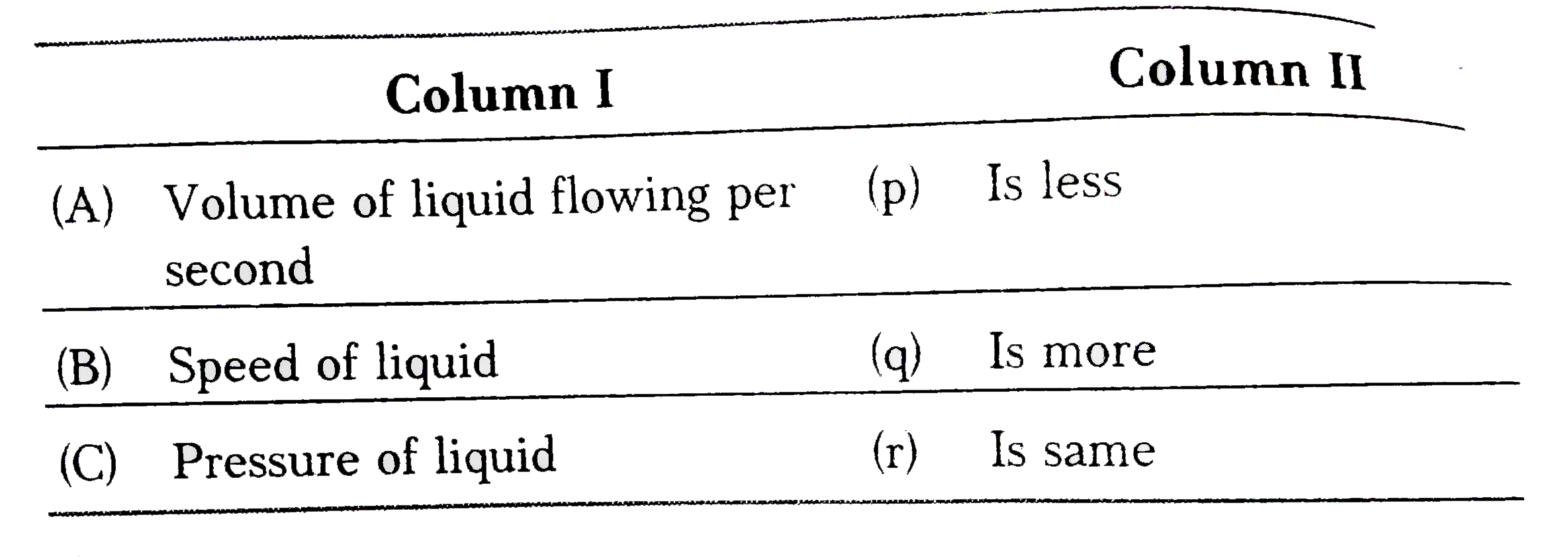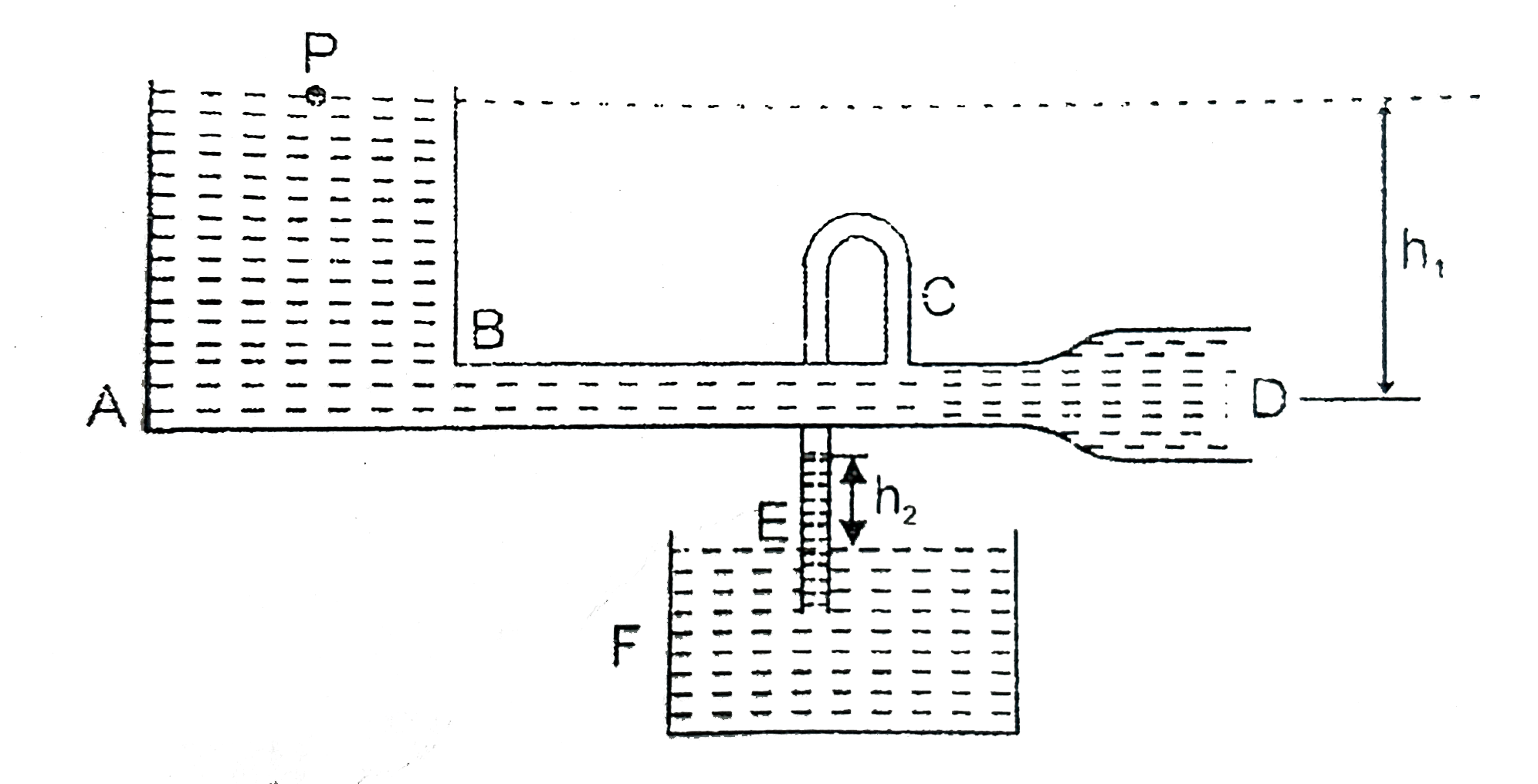_E01_111_Q01.png)
Water coming out of the mouth of a tap and falling vertically in stream line flow forms a tapering column. i.e., the area of cross-section of the liquid column decreases as it moves down which of the following is the most accurate explanation for this-
As the water moves down, its speed increases and hence its pressure decreases. It is then compressed by the atmosphere
Falling water tries to reach a terminal velocity and hence reduces the area of cross-section to balance upward and downward forces
The mass of water flowing past any cross-section must remain constant. Also, water is almost incompressible. Hence, the rate of volume flow must remain constant. As this is equal to velocity × area, the area decreases as velocity increases
The surface tension causes the exposed surface area of the liquid to decrease continuously
The correct Answer is:C
Step by step video, text & image solution for Water coming out of the mouth of a tap and falling vertically in stream line flow forms a tapering column. i.e., the area of cross-section of the liquid column decreases as it moves down which of the following is the most accurate explanation for this- by Physics experts to help you in doubts & scoring excellent marks in Class 11 exams.
Updated on:21/07/2023Topper's Solved these Questions
Similar Questions
_E01_111_Q01.png)
Water coming out of the mouth of a tap and falling vertically in stream line flwo forms a tapering column. i.e., the area of cross-section of the liquid column decreases as it moves down which of the following is the most accurate explanantion for this-
View SolutionA liquid is flowing through a pipe of non-uniform cross-section. At a point where area of cross-section of the pipe is less, match the following columns.

View Solution
Knowledge Check
In the previous question, at the mouth of the tap the area of cross-section is 2.5cm2 and the speed of water in 3m/s. The area of cross-section of the water column 80cm below the tap is.
A2cm2B1.5cm2C1cm2D0.5cm2While going down in the group of non-metals (14, 15, 16 and 17) the electronegative character of non-metals decreases. Typical example is of group 15 elements. The elements nitrogen (2nd period) and phosphorus (3rd period) are non-metals and their oxides are acidic in nature. The elements arsenic (4th period) and antimony (5th period) are metalloids and their oxides are amphoteric in nature. However, bismuth (6th period) is a metal. Thus, we can see that the electronegative character (non-metallic character) of elements gradually decreases and ultimately the last element becomes metal. In case of group 17 of halogens, the first member of the group i.e., fluorine is most non-metallic in character and last member of group, i.e., astatine is least non-metallic in character. In other words, the electronegative nature of the elements decreases as we move down the group.
Which of the following is the most metallic element?APBNCBiDAsWhile going down in the group of non-metals (14, 15, 16 and 17) the electronegative character of non-metals decreases. Typical example is of group 15 elements. The elements nitrogen (2nd period) and phosphorus (3rd period) are non-metals and their oxides are acidic in nature. The elements arsenic (4th period) and antimony (5th period) are metalloids and their oxides are amphoteric in nature. However, bismuth (6th period) is a metal. Thus, we can see that the electronegative character (non-metallic character) of elements gradually decreases and ultimately the last element becomes metal. In case of group 17 of halogens, the first member of the group i.e., fluorine is most non-metallic in character and last member of group, i.e., astatine is least non-metallic in character. In other words, the electronegative nature of the elements decreases as we move down the group.
Which of the following is the most non-metallic element?AFBClCBrDI
A cylindrical container of cross-section area, A is filled up with water upto height 'h' Water may exit through a tap of cross sectional area 'a' in the bottom of container. Find out

(a) Velocity of water just after opening of tap.
(b) The area of cross-section of water stream coming out of tape at depth h0 below tap in terms of 'a' just after opening of tap.
(c) Time in which conainer becomes empty.
(Given : (aA)1/2=0.22,h=20cm,h0=20cm
View SolutionTwo very large open tanks A&F both contain the same liquid. A horizontal pipe BCD, having a small constriction at C, leads out of the bottom of tank A, and a vertical pipe E containing air opens into the constriction at C and dips into the liquid in tank F. Assume stremline flow and no viscosity. If the cross section area at C is one-half that at D, and if D is at distance h1 below the level of the liquid in A, to what height h2 will liquid rise in pipe E? Express your answer in terms of h1.
[Neglect changes in atmosphere pressure with elevation. In the containers there is atmosphere above the water surface and D is also open to atmosphere.]

View SolutionWater from a tap of cross sectional area 1cm2 starts falling down vertically, with a speed of 1m/s. What is the area of cross section of the stream of water at a distance of 20cm below the mouth of the tap?
[Assume that (1) the flow is steady, (2) pressure is constant throughout the stream of water and g=10m/s2]
View SolutionIf water falls from a tap, then the volume rate of flow of water at depth of h, (A0 is the area of cross-section of the mouth and A02 is the corresponding area at depth h)
View SolutionThe figure shows the commonly observed decrease in diameter of a water stream as it falls from a tap. The tap has internal diameter D0 and is connected toa large tank of water. The surface of the water is at a height b above the end of the tap.
By considering the dynamics of a thin "cylinder" of water in the steam answer the following: (ignore any reistance to the flow and any effects of surface tansion, given ρw= density of water)

Which of the following equation expresses the fact that the flow rate at the tap is the same as at the stream point with diameter D and velocity v (i.e. D in terms of D0,v0 and v will be) :
View Solution

